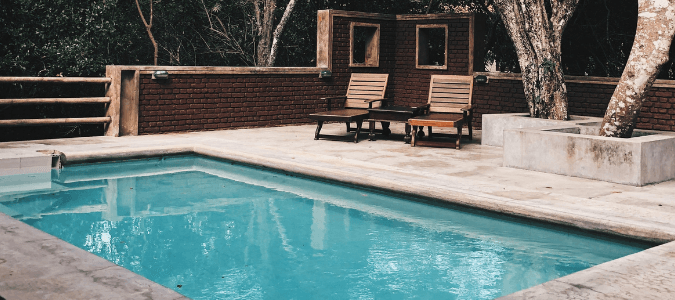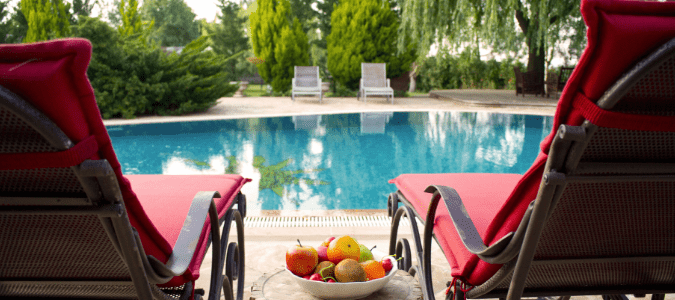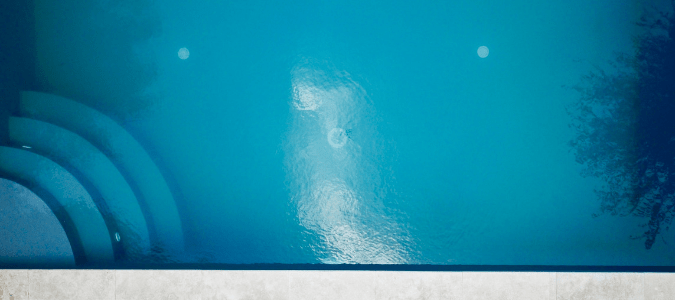If you have lived in the area for long, you know that summer and even late spring can range from warm to scorching hot. When the mercury rises, it can be difficult to even imagine spending time outdoors unless it involves a way to cool off. That is where a backyard pool can be a lifesaver. The idea of jumping into the cooling water of your very own pool is a dream come true.
Of course, pools are not only essential in such a warm climate, they also serve as a beautiful focal point for your yard. Additionally, they can increase your home’s value should you ever be in the market to sell. But like everything else related to a home, pools come with their fair share—or more—of work. Not only keeping leaves out of the water and maintaining the proper chemical balance. The surface of your pool likely will eventually need attention as well.
Above Ground
Above-ground pools use a vinyl liner to keep the water contained within the framework of the pool structure. You will find three kinds of liners: overlap, beaded and unibead.
Overlap liners are the least-expensive option. You use what is called coping strips to hold the liner on the pool wall. These strips are plastic and work like a wide paper clip that attaches the vinyl to the top of your pool. These liners are not difficult to install, but they have limited styles such as solid colors or a pattern that is uniform.
Beaded liners basically snap into a bead receiver that is installed on the top of the pool frame. It’s the easiest to install and because it goes in evenly around the pool, it comes in an array of designs and patterns to enhance the look of the pool.
Unibeaded liners are very versatile and look very professional. You can use a bead receiver, like a beaded liner, or as a J-hook liner. These come in many patterns and do a good job protecting your above-ground pool.
In-Ground
For an in-ground pool, look for the signs that it is time for a resurfacing. If you notice plaster flaking and peeling along the steps or the bottom of your pool, that is a red flag. You might also see that the surface of your pool lining is developing stains, which are called topical stains.
Copper, salt and calcium deposits cause bluish gray spots along the surface. These can be cleaned with an acid wash. But, doing so can further damage the plaster and make a resurfacing even more necessary. An acid wash or polishing can also fix a rough surface that makes it feel like you are walking on sandpaper when you go for a dip. However, this is just a temporary repair and can cost just about as much as refinishing the surface. And, there’s no guarantee that it will completely alleviate the problem.
Maybe you see stains at the bottom of the pool that are more of a rust color. Those could come from rebar or a tie wire from the pool’s shell. If these are oxidizing, they will produce that type of stain. You can cover these, but it will leave the surface of the pool floor rough. A full resurfacing might be needed. A pool professional can assess the damage and offer the best solution for taking care of any stains.
Cracks are a sure sign you either have or will have a problem. Check cracks are long cracks that don’t hurt the structure of your pool liner, at least not right away. They aren’t always easy to see, so you might not notice them unless you drain the pool for cleaning. Unfortunately, draining the pool creates a situation where the temperature changes quickly from cool to hot. This can make the cracks even more extensive.
Structural cracks are much more concerning. If you are having to fill your pool more and more often, take a look all around the lining and see if you have any large cracks or cracks that have grown larger over time. If so, it means the crack is not just in the surface but beyond, and your pool water is seeping out into the ground. Replastering won’t be enough in this case. You will need to fill in the cracks and if they are bad enough, you might need to call in a civil engineer and rebuild part of the pool. It’s a good idea to call in a pool professional to inspect the cracks. They can determine the severity and the remediation. Even better, call in an expert on a regular basis so they can find potential issues before they become a big problem.
If you have already repaired your pool surface with a paint that is a fiberglass overlay, after a few years you likely will see some deterioration. If you notice that your pool is cloudy and chalky looking or the surface is delaminating, it’s time to consider taking that overlay out and using something else instead. A professional who provides pool service can notify you when it’s time to make a more permanent fix.
Pool Resurfacing Versus Replastering
Typically, in-ground pool surfaces are made up of tile, pebble, fiberglass or plaster laid over the concrete pool shell. Eventually, though, you will need to consider renewing the entire surface. Some people call the process “resurfacing,” and others say “replastering.” Both mean essentially the same thing.
Resurfacing should last decades, depending on the type. If you use white quartz, you can expect a lifespan of 10 years; exposed pebble should last about 15 years; and a white plaster or polished finish will hold up for 5 to 15 years. By signing up for ongoing pool service, your pool’s exterior can last longer.
How to Resurface a Pool
Obviously, the process is different depending on which materials you choose for the resurfacing. Plaster is the most common choice, and not surprisingly as it is also the least expensive material to use.
A pool professional can take off the old plaster by chipping it or using a sandblaster, leaving the original concrete shell in place. Next comes application of a bonding coat, followed by a couple of coats of plaster. You can choose the color of the plaster to suit your tastes. Though plaster does well with the pool water over time, it doesn’t usually last as long and isn’t as durable as some other options.
Pebble finishes on pools are gaining popularity, though this style has been around for a long time. This style looks very natural and is eye-catching. Plus, it tops plaster in areas such as strength, scratch resistance, durability, care and maintenance. You will generally get a better warranty than you will from plaster, usually 10 years compared to one year or so with a plaster resurfacing.
A very popular choice is fiberglass, because it is flexible and holds its own if the ground around the pool shifts. First, a pool professional smoothes the surface, filling in any cracks or chips, then reinforcing and sanding those repairs.
Then comes the application of several layers of pool-friendly products. Your pool pro will add a coat of resin, then a coat of fiberglass. This will also get a sanding. Up to three top coats will seal the surface, and you can pick a wide variety of textures and colors to fit your style.
Fiberglass lasts longer than concrete or plaster and absorbs fewer of the chemicals used to keep a pool clean. It also absorbs less organic material than other choices. Even better, fiberglass resists staining from algae.
The most expensive option is using tile to cover your pool interior. It takes a lot of labor and the materials are much more pricey, but the result is the height of luxury. The best route is to contact a pool professional. They can recommend the best material to use and give you a quote on how much resurfacing might cost. Replastering your pool is a big job no matter which type you choose. Let the experts handle it! All that will be left for you to do is jump in and enjoy your “new” pool.
ABC Can Make Your Pool Look Brand New
Getting your pool resurfaced is an essential part of owning a pool. When it comes time to get your pool resurfaced, contact ABC Home & Commercial Services. We can take care of all aspects of your pool maintenance and remodeling. We can even winterize your pool, so it’s taken care of when temperatures drop.


